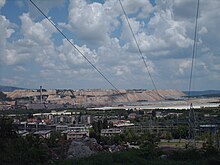Bor (Serbia)
|
Бор Bor |
||||
|
||||
| Basic data | ||||
|---|---|---|---|---|
| State : | Serbia | |||
| Okrug : | boron | |||
| Coordinates : | 44 ° 5 ' N , 22 ° 6' E | |||
| Height : | 378 m. i. J. | |||
| Residents : | 34,160 (2011) | |||
| Telephone code : | (+381) 030 | |||
| Postal code : | 19210 | |||
| License plate : | BO | |||
| Structure and administration | ||||
| Mayor : | Aleksandar Milikic ( SNS ) | |||
Bor ( Serbian - Cyrillic Бор ) is a city with 34,160 inhabitants in Serbia and the location of one of the largest copper mines in Europe . The city is the administrative seat of the Okrug Bor and the Opština Bor . The name Bor literally means the plant pine .
geography
Bor is a town in Timočka Krajina . It is surrounded by several health resorts such as Banjsko Polje and Brestovačka Banja, as well as Lake Bor and the mountains of Stol and Crni Vrh ( Black Peak ). Nearby is one of the largest caves in the Balkans, the Lazareva pećina ( Lazarus Cave ).
history
Already in the Bronze Age, 2200 to 800 BC. BC, copper was extracted in the area around Bor. Corresponding ovens and graves were found.
In 1835 August von Herder visited the Bor region at the invitation of Prince Miloš Obrenović to carry out geological surveys. In 1914 the geologist Conrad Schlumberger was in the Bor region.
The Orthodox Church of St. George was built between 1911 and 1912 .
Bor has had the status of a town since 1947 .
coat of arms
The diagonally divided shield shows a green pine tree with a brown trunk on a yellow background at the top right.
economy
One of the largest copper deposits in Europe is located in Bor. In 1903 the area with the copper deposits was bought by the industrialist Georg Weifert and in June 1904 the copper mine was opened with French participation. From 1914 to 1922 Friedrich Wilhelm Kegel managed the mine.
On March 27, 1941, Hitler ( directive no. 25 ) ordered the attack on Yugoslavia . In the instruction of the Führer it was mentioned that the possession of the copper mines of Bor should have been important for reasons of defense economy . In 1943 Hungarian Jewish slave laborers were imprisoned in Bor. The copper mines covered 50 percent of the copper requirements of the German arms industry .
Bor's copper mines are the main employer in the region. In addition, tourism is becoming more and more important.
Demographics
Previous censuses:
- 1931: 4,749
- 1948: 10.823
- 1953: 14.244
- 1961: 18.496
- 1971: 29.118
- 2002: 39,387
Twin cities
Bor maintains city partnerships with the following cities:
-
 Bar , Montenegro
Bar , Montenegro
-
 Le Creusot , France
Le Creusot , France
-
 Khmelnytskyi , Ukraine
Khmelnytskyi , Ukraine
-
 Kitwe , Zambia
Kitwe , Zambia
-
 Wraza , Bulgaria
Wraza , Bulgaria
badges and flags
sons and daughters of the town
- Nikola Šainović (* 1948), politician
literature
- Sabine Rutar: Work and Survival in Serbia. The Bor copper ore mine in World War II , in: Geschichte und Gesellschaft , 31st year, no. 1 (Labor deployment and forced labor in occupied Europe, 2005), pages 101-134.
Individual evidence
- ↑ Statistical Office of the Republic of Serbia: 2011 Census of Population, Households and Dwellings. Volume 1 p. 68.
- ↑ Turistička Organizacija Bor: Lazareva pećina
- ^ Prehistoric copper mining in Bor, in Serbia . In: Der Standard online , December 12, 2019, accessed on December 12, 2019.
- ↑ Eleonore Lappin-Eppes: Hungarian-Jewish forced laborers in Austria 1944/45. Labor deployment death marches consequences. LIT, Vienna 2010, ISBN 978-3-643-50195-0 , pp. 16-18. Memorial portal: Bor
- ↑ Official website of the copper mines (Serbian, English)
- ↑ Official website of Turistička organicacija Bor (Serbian)
- ↑ Opšta Državna Statistika: Definitivni rezultati popisa stanovništva od 31 marta 1931 godine. Knjiga 2: Prisutno stanovništvo po veroispovesti . Državna Štamparija, Belgrade 1938, p. 76. Popis stanovništva i stanova 1971, Knjiga 7: Stanovništvo i domaćinstava u 1948, 1953, 1961, 1971. Savezni zavod za statistiku. Belgrad 1975, p. 289. Republic of Serbia: 2002 Census of population, households and dwellings, Volume 1, p. 92.
Web links
- Official website of the city of Bor (Serbian)




